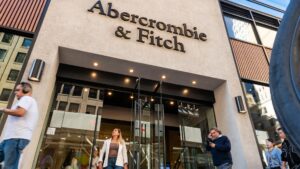Abercrombie & Fitch: Navigating Challenges Amid Slowing Growth
Abercrombie & Fitch, a name that once epitomized teenage fashion, now finds itself at a crossroads, facing a slowdown in growth as it enters fiscal 2025. While the retailer has achieved substantial momentum over the past few years, recent updates indicate that its trajectory might be leveling off. At Extreme Investor Network, we explore the implications of Abercrombie’s latest financial guidance and share insights on what lies ahead for this iconic brand.
Disappointing Guidance Tempts Wall Street’s Response
In a release that sent its stock tumbling over 7% in premarket trading, Abercrombie projected a sales growth of only 3% to 5% for fiscal 2025—well below analysts’ expectations of 6.8%. This cautious outlook suggests that the company may be struggling to maintain the momentum that fueled its two-year sales and stock surge. Earnings per share are estimated to be between $1.25 and $1.45, falling short of the anticipated $1.97.
Despite the dispiriting guidance, Abercrombie did manage to narrowly beat Wall Street estimates for its fiscal fourth quarter. The company reported earnings per share of $3.57 against expectations of $3.54, with revenues reaching $1.58 billion—slightly ahead of the $1.57 billion analysts expected. This cautious optimism reflects a mixed bag for investors.
Key Performance Metrics Take Center Stage
While Abercrombie’s recent performance showed promise, focusing solely on numbers reveals complexities. The retailer’s reported net income for the quarter was $187 million, marking an increase from $158 million year over year. Even more interesting is how sales rose 9% compared to the previous year, defying the impact of a less favorable comparative selling period.
However, the forecast for operating margins raised eyebrows. Abercrombie anticipates margins to range between 8% and 9%, significantly lower than the Street’s expectation of 12.8%. This downward revision amplifies questions about the company’s ability to manage costs efficiently amidst changing consumer sentiment.
Emerging Trends and Consumer Behavior
The broader industry landscape plays a pivotal role in shaping Abercrombie’s future. Consumer confidence has dipped to levels not seen since 2021, influenced by geopolitical tensions, economic uncertainty, and seasonal weather anomalies. Such factors are particularly concerning for specialty retailers, as discretionary spending on items like clothing often declines in times of caution.
Interestingly, the slowdown is more pronounced within Abercrombie’s namesake brand, while its subsidiary, Hollister—targeted more towards a younger demographic—achieved impressive growth, with 16% sales increases compared to just 2% for Abercrombie. This points to a potential shift in youth fashion preferences, highlighting the urgent need for Abercrombie to innovate and re-engage its target market effectively.
Strategic Shifts for Future Growth
Not all of Abercrombie’s news is grim. The company remains focused on building its international presence, and some aspects of its guidance have generated enthusiasm. Its projected sales growth of 4% to 6% for the current quarter aligns closely with market expectations, and anticipated earnings between $10.40 and $11.40 per share suggest a commitment to profitability over sheer sales.
Abercrombie’s management has also signaled a pivot towards profitability. CEO Fran Horowitz recently emphasized the importance of enhancing shareholder value and leveraging the company’s operational strengths to achieve sustainable growth in its markets.
In a testament to its long-term strategy, Abercrombie announced a substantial $1.3 billion share repurchase authorization with an expectation to spend $400 million on stock buybacks in 2025. This proactive move reflects confidence in brand strength and the overall business model.
The Road Ahead: Balancing Growth with Sustainability
As Abercrombie & Fitch strives to regain its footing, investors remain cautiously optimistic about its path forward. With a redefined focus on profits and an eye on improving brand engagement, Abercrombie has the potential to reignite its growth engine. However, it will increasingly need to address consumer trends authentically and innovate its marketing strategies—particularly in leveraging platforms like TikTok, which have become crucial for engaging younger audiences.
At Extreme Investor Network, we believe that the coming months will be critical for Abercrombie as it navigates this transitional phase. Keeping an eye on operational efficiencies while fostering brand affinity will be essential to ensuring that the iconic brand remains not just relevant but thriving in the competitive apparel landscape. Stay tuned as we continue to provide updates and insights on Abercrombie’s journey and the business world at large.

